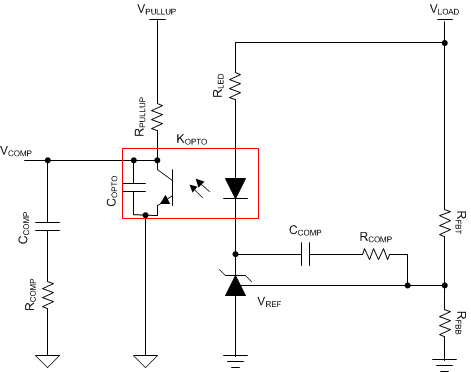SNVA866A February 2019 – January 2023 LM5155 , LM5155-Q1 , LM51551 , LM51551-Q1
- How to design an Isolated Flyback using LM5155
- Trademarks
- 1Introduction
- 2Example Application
- 3Calculations and Component Selection
- 4Component Selection Summary
- 5Small Signal Frequency Analysis
- 6Revision History
3.9 Control Loop Compensation
In this section, a general technique is described to stabilize the control loop for a peak current mode controlled flyback regulator in continuous conduction mode operation. Figure 3-2 shows circuit that implements the isolated feedback path. To maintain the voltage isolation between the primary side and secondary side an optocoupler is used. In Figure 3-2 the FB pin of the LM5155 is tied to ground. COPTO is the parasitic capacitance of the optocoupler. This value is dependent upon the selected RPULLUP value and can be estimated using the optocoupler data sheet. Assuming the CCOMP is much larger than COPTO, helps to simplify the loop calculations. However, a pole is formed by RPULLUP and COPTO which is considered for accurate loop modeling. For a detailed model of the isolated feedback transfer function see Table 5-2.
There are many different strategies to set the crossover frequency of the control loop, and correctly place the poles and zeros of the feedback path to achieve stable operation. The loop compensation selection process is broken down into a number of simplified steps described in the following sections.
 Figure 3-2 Isolated Feedback
Figure 3-2 Isolated Feedback